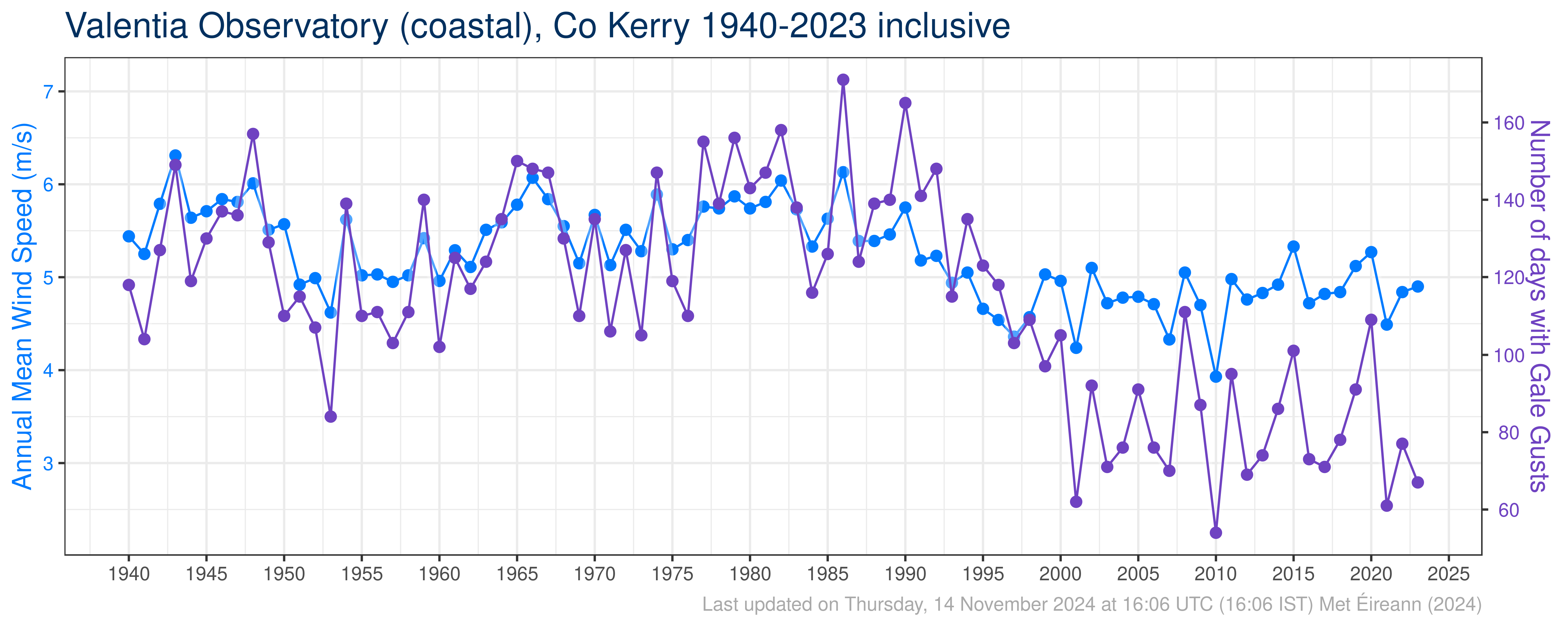Wind over Ireland
The wind at a particular location can be influenced by a number of factors such as obstruction by buildings or trees, the nature of the terrain and deflection by nearby mountains or hills. For example, the rather low frequency of southerly winds at Dublin Airport is due to the sheltering effect of the mountains to the south. The prevailing wind direction is between south and west. Average annual wind speeds range from 3m/s in parts of south Leinster to over 8 m/s in the extreme north. On average there are less than 2 days with gales each year at some inland places like Carlow, but more than 50 a year at northern coastal locations such as Malin Head.
Diurnal Variation of Wind Speed
During the course of a typical day, the range (difference between the highest and lowest) of mean hourly wind speed is considerable. At Belmullet, a western coastal station, the mean diurnal range is 11.5 m/s in January and is still as high as 8.4 m/s in July. At Clones, a typical inland station the mean diurnal range is 8.4 m/s in January and 6.2 m/s in July. The diurnal variation is much more pronounced in summer than in winter. This is a result of surface heating, which increases mixing of the faster-moving air at higher levels with the air near the surface. As the effect of surface heating diminishes, the wind speed decreases and during the night there is little variation from hour to hour. The diurnal variation is greatest on sunny days and least on dull days. The tendency for maximum wind speed to occur in the afternoon is noticeable only in the long-term figures and on individual days the maximum may be at any hour.
Wind Direction
Wind blows most frequently from the south and west for open sites while winds from the northeast or north occur least often. In January the southerly and south-easterly winds are more prominent than in July, which has a high frequency of westerly winds. Easterly winds occur most often between February and May and are commonly accompanied by dry weather. The influence of topography can be seen in the low frequency of winds from a south easterly direction at Valentia Observatory, and winds from a southerly direction at Dublin Airport.
Click station to view data.
 |
 |
Measurements
Wind is the movement of air caused by pressure differences at the earth’s surface, which in turn are caused by the differential heating of the earth’s surface by the sun. Winds play a key role in the global transport of heat and energy. The wind regime at the surface is influenced by local topography. Wind measuring sites need to be open, level and free from obstructions due to buildings and trees etc., for this reason wind speed and direction are measured generally at 10m above ground level.

Wind has been measured in Ireland since the late 19th century. Wind speed and direction are measured at synoptic weather stations. Up until the 1990s, wind speed and direction were measured by Dines pressure tube anemometers, these operate on the basis of the pressure caused by the wind blowing into an opening on the wind facing end of a wind vane, since the early 1990s these have been replaced by cup and vane anemometers, with wind speed measured by rotating cups, and direction by a separate wind vane.
The wind at a particular location can be influenced by a number of factors such as obstruction by buildings or trees, the nature of the terrain (roughness) and deflection by nearby mountains or hills. Inhomogenieties arise in wind data time series due to changes in instrumentation and changes in station exposure due to new buildings, tree growth etc. in the vicinity of the station. Data used in this section have not been homogenised or corrected for roughness.
Wind speed and direction are continuously recorded and tabulated, either manually or automatically depending on the station location and type. Gust speeds are also recorded, as are the times of highest daily gusts and the mean wind speed and direction at the time of the highest gust and the highest 10 minute mean speed in a 24 hour period.
Time Series and Trends: Mean annual wind speeds and the number of days per year with gale gusts (a gust of greater than 17.5 m/s or 34kt) are shown below for Valentia and Dublin Airport.


Note (2 Jun 2023): Values from 2010 and 2011 are under investigation due to missing data at Valentia Observatory. Every effort is being to retrieve these.
Queries to enquires@met.ie and quote reference “SS-Wind04”.